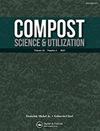蚯蚓生物床处理牛粪及辣椒苗基质的研制
IF 0.9
4区 农林科学
Q3 ECOLOGY
引用次数: 4
摘要
摘要:由于泥炭枯竭的负面影响,Vermicompost正成为园艺中泥炭的重要替代品。蚯蚓直接消化新鲜牛粪的过程中没有进行好氧发酵预处理,这导致蚯蚓堆肥与传统处理方法相比具有不同的性质。然而,在蚯蚓直接消化过程中,对蚯蚓堆肥的性质了解有限。本研究采用大型蚯蚓生物床将新鲜牛粪转化为蚯蚓堆肥,然后测定了蚯蚓堆肥的物理、化学和微生物特性。为了研究矿物营养添加的影响,将蚯蚓堆肥与蛭石以4:1(v/v)的比例混合,然后用作辣椒幼苗的生长培养基。结果表明,蚯蚓堆肥中的硝酸盐氮(243.39mg/kg)、铵态氮(50.38mg/kg)、总磷(47.61g/kg)、有效磷(41.68g/kg)、过氧化氢酶活性(2.17mL/g·h)、细菌生物量(3.60×107cfu/g)、放线菌生物量(2.40×107fu/g)和真菌生物量(1.55×106cfu/g)显著高于亲本。然而,与亲本相比,蚯蚓堆肥中的水分(50.01%)、电导率(2.07mS/cm)、总氮(8.52g/kg)、有机质(28.47%)和脲酶活性(0.63mL/g·h)显著降低。蚯蚓堆肥处理的地上部和根部形态指数以及辣椒生物量积累测量结果优于商业泥炭培养基(CK)。在添加尿素(0.5 kg/m3)、过磷酸钙(10.0 kg/m3)的蛭石混合培养基中,叶展度(14.83 cm)、茎高(24.20 cm)、干径(4.38 cm)、叶数(16.20个)、根长(352.83 cm),和氯化钾(1.0kg/m3)。矿物质营养素(NPK)的添加对蚯蚓堆肥基质的物理性质影响不大,但提高了有效营养素。总之,未经预处理的新鲜牛粪可以使用大型蚯蚓生物床加工成蚯蚓堆肥。Vermicopost可以作为商业泥炭培养基的替代品用于辣椒插塞苗的培养,并且随着幼苗生长时间的增加,添加NPK的有益效果逐渐显现。本文章由计算机程序翻译,如有差异,请以英文原文为准。
Cow Manure Disposal Using an Earthworm Bio-Bed and the Development of a Vermicompost-Based Substrate for Capsicum Seedlings
ABSTRACT Vermicompost is becoming an important substitute for peat in horticulture due to the negative consequences of peat depletion. There is no aerobic fermentation pretreatment in the process of direct digestion of fresh cow manure by earthworms, which resulted in different properties of vermicompost compared with traditional treatment methods. However, there is limited knowledge on the properties of vermicompost in the direct earthworm digestion process. In the present study, a large-scale earthworm bio-bed was used to convert fresh cow manure into vermicompost, and then the physical, chemical, and microbial properties of the vermicompost were determined. To study the influence of mineral nutrient additions, vermicompost was mixed with vermiculite at a ratio of 4:1 (v/v), and was then used as the growth medium for capsicum seedlings. The results showed that nitrate nitrogen (243.39 mg/kg), ammonium nitrogen (50.38 mg/kg), total phosphorus (47.61 g/kg), available phosphorus (41.68 g/kg), catalase activity (2.17 mL/g·h), bacterial biomass (3.60 × 107 cfu/g), actinobacterial biomass (2.40 × 107 cfu/g), and fungal biomass (1.55 × 106 cfu/g) measurements were significantly higher in vermicompost than in the parent material. However, moisture (50.01%), electrical conductivity (2.07 mS/cm), total nitrogen (8.52 g/kg), organic matter (28.47%), and urease activity (0.63 mL/g·h) were significantly lower in the vermicompost compared to the parent material. The shoot and root morphological indices and the capsicum biomass accumulation measurements in the vermicompost treatments were superior to those found in the commercial peat medium (CK). Leaf expansion (14.83 cm), shoot height (24.20 cm), stem diameter (4.38 cm), leaf number (16.20 No.), root length (352.83 cm), root surface area (60.30 cm2), root diameter (0.61 mm), and root volume (0.92cm3) significantly higher in vermicompost-vermiculite mixed media with added urea (0.5 kg/m3), superphosphate (10.0 kg/m3), and potassium chloride (1.0 kg/m3) than in CK at the late seedling growth stage. The addition of mineral nutrients (NPK) had little effect on the physical properties of the vermicompost media, but it improved the available nutrients. In summary, fresh cow manure without pre-treatment can be processed into vermicompost using a large-scale earthworm bio-bed. Vermicompost could serve as an alternative for commercial peat media in the cultivation of capsicum plug seedlings, and the beneficial effects of adding NPK gradually emerged as the seedling growth time increased.
求助全文
通过发布文献求助,成功后即可免费获取论文全文。
去求助
来源期刊

Compost Science & Utilization
农林科学-生态学
CiteScore
4.10
自引率
0.00%
发文量
0
审稿时长
>36 weeks
期刊介绍:
4 issues per year
Compost Science & Utilization is currently abstracted/indexed in: CABI Agriculture & Environment Abstracts, CSA Biotechnology and Environmental Engineering Abstracts, EBSCOhost Abstracts, Elsevier Compendex and GEOBASE Abstracts, PubMed, ProQuest Science Abstracts, and Thomson Reuters Biological Abstracts and Science Citation Index
 求助内容:
求助内容: 应助结果提醒方式:
应助结果提醒方式:


